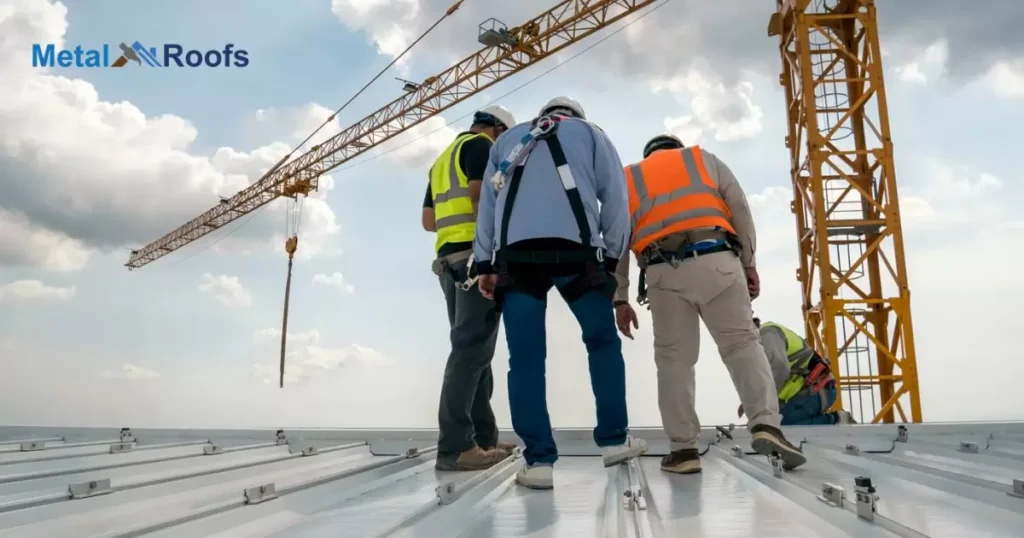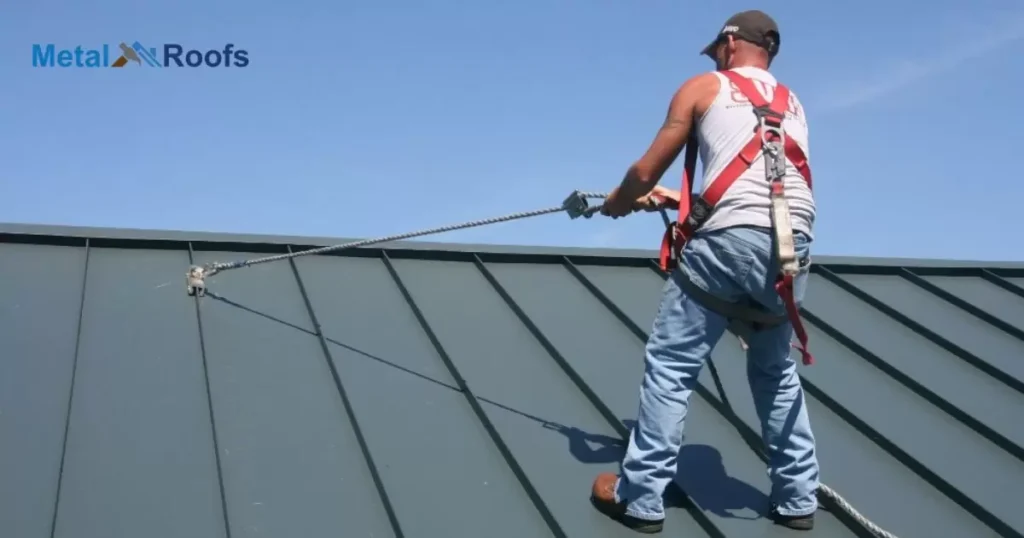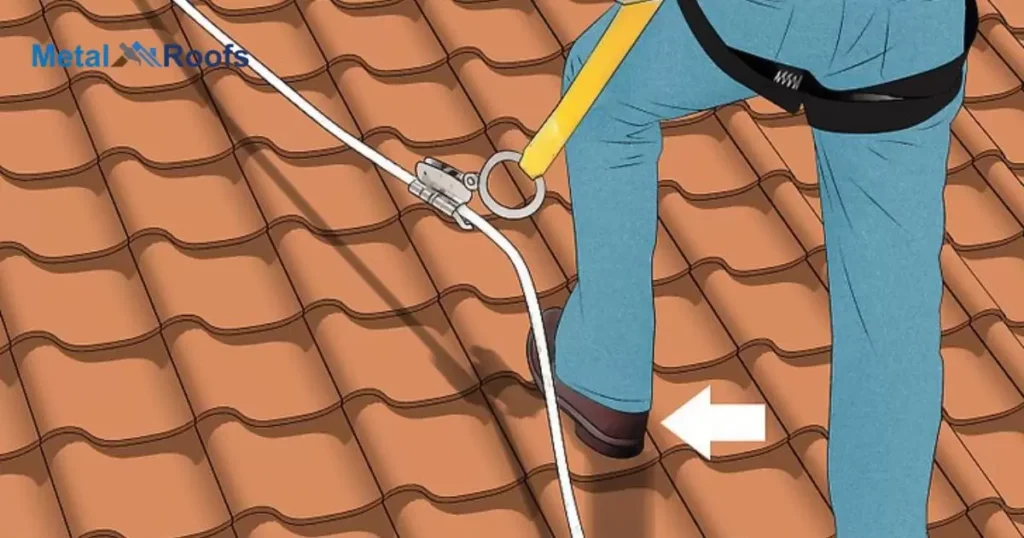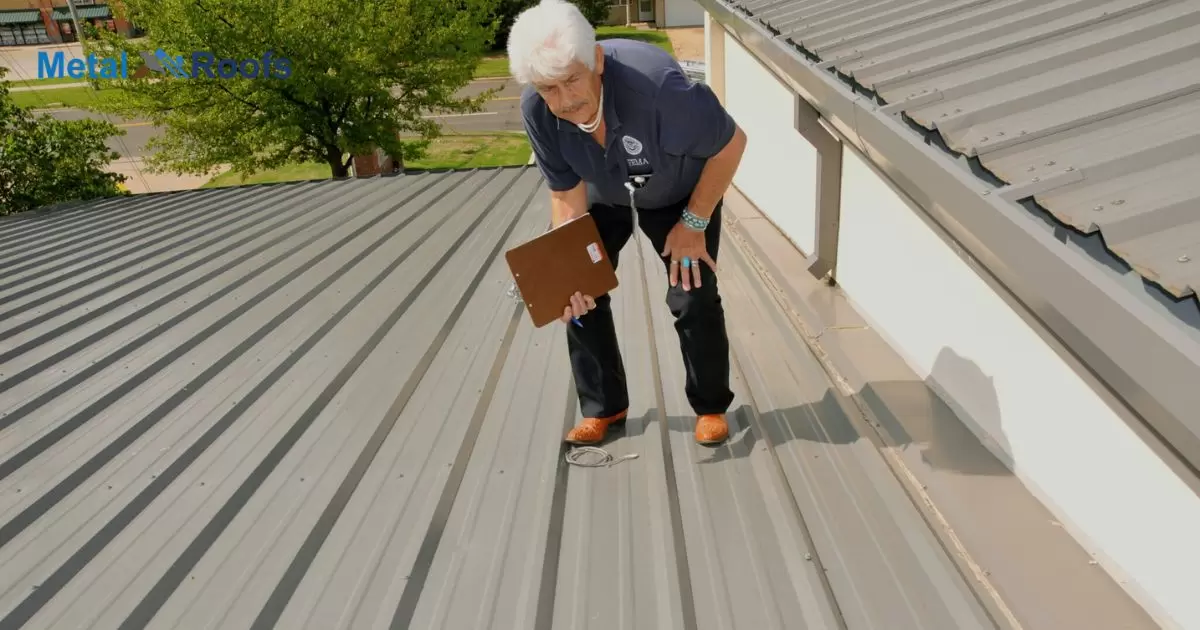Metal roofs can be slippery when wet or icy. The smooth surface provides little traction. Stepping cautiously is important and railings or harness attachments may help prevent falls while working on them.
Metal roofs seem slick enough when wet. But add mold, moss, or algae and they become treacherous. Learn how to make a metal roof slippery for safety’s sake. Understanding causes like excess moisture allows precautions against falls, injuries or worse.
A metal roof’s slick surface already endangers stability. But moisture enables mold, moss, and algae to grow. This additional slipperiness risks life and limb. Learning what causes this helps prevent accidents.
Key Takeaways
- Walking on metal roofs can be risky; prioritize safety measures like proper footwear and cautious steps.
- Regularly clean and inspect metal roofs to prevent debris buildup and ensure long-term slipperiness.
- Apply non-stick coatings and conduct repairs promptly to maintain slipperiness and enhance roof durability.
- Consider hiring roofing experts for complex tasks to ensure safety and optimal performance.
3 Steps for Walking on Metal Roofs
Walking on metal roofs can be dangerous. The surface is often slippery, especially when wet or icy. It’s easy to lose balance and fall.
To stay safe, wear proper footwear with good traction. Take slow, deliberate steps and use handrails if available. Avoid walking on metal roofs altogether if possible, especially during adverse weather conditions.
Choose the Right Footwear
For walking on metal roofs, selecting the right footwear is crucial. Opt for shoes with sturdy rubber soles for better grip. Avoid shoes with smooth or worn-out soles that can increase the risk of slipping. Prioritize safety by choosing footwear that provides traction and stability.
Wait for a Clear Day
When walking on metal roofs, wait for a clear day. Rain, snow, or ice can make the surface dangerously slippery. Choose a time when the weather is dry and stable to minimize the risk of slipping.
Be Safe
When it comes to walking on metal roofs, safety is paramount. Always prioritize your well-being. Wear appropriate footwear for better grip and stability. Take your time and be cautious with every step. Keep a firm hold on handrails if they’re available.
Before You Walk on a Metal Roof

Before stepping onto a metal roof, assess the conditions. Check for any signs of damage or instability. Ensure proper footwear for traction and safety. Take note of the weather, avoiding walking on the roof during rain, snow, or ice.
Plan your route and use handrails if available. Communicate with others nearby about your intention to walk on the roof. Always proceed with caution, taking slow and deliberate steps. Prioritize your safety above all else when walking on a metal roof, as they can make noise.
Shoes and Footwear for Walking on Metal Roofs
Choosing the right footwear for walking on metal roofs is crucial. Opt for shoes with excellent traction. Look for sturdy soles to grip the metal surface securely. Avoid footwear with worn-out treads that could cause slips. Your safety depends on the quality of your shoes.
Rubber Soles and Lugs
For walking on metal roofs, consider rubber soles with lugs. Rubber provides excellent traction on smooth surfaces. Lugs help grip onto the metal securely, reducing the risk of slipping. Prioritize shoes with these features for safer roof walking.
Basics of Traction on Metal Roofs
Traction on metal roofs is an important consideration for safety, especially in environments prone to rain, snow, or ice. Here are some basics regarding traction on metal roofs:
Material and Finish: Metal roofs can be made from various materials such as steel, aluminum, or copper. The finish applied to the metal can affect traction. Textured or granular finishes can provide better traction compared to smooth finishes.
Pitch and Slope: The pitch or slope of the roof affects how water, snow, and ice will accumulate. Steeper pitches generally shed precipitation more effectively, reducing the risk of slippery conditions. However, even on steep pitches, traction can be a concern in certain weather conditions.
Weather Conditions: Weather plays a significant role in traction on metal roofs. Rain can make metal surfaces slippery, while snow and ice can create hazardous conditions. It’s essential to consider the climate of the area when evaluating traction needs.
Traction Aids: Various traction aids can be installed on metal roofs to enhance safety. These may include:
- Special coatings applied to the metal surface to improve grip.
- Devices installed on the roof to prevent snow and ice from sliding off in large chunks, reducing the risk of injury from falling ice and creating more manageable conditions for traction.
- Installed for safety harnesses and other fall protection systems to ensure workers can maintain traction while working on the roof.
- Designated areas with enhanced traction for safe movement on the roof, especially in areas with high foot traffic.
Regular Maintenance: Proper maintenance of the roof is crucial for ensuring optimal traction. This includes keeping gutters clear to prevent water from backing up and creating slippery conditions, removing debris that could impede drainage or create uneven surfaces, and promptly addressing any damage or wear that could affect traction.
Safety Precautions: Individuals working on metal roofs should always take appropriate safety precautions, including wearing slip-resistant footwear, using safety harnesses and fall protection equipment when necessary, and avoiding working on the roof during inclement weather conditions whenever possible.
By considering these factors and implementing appropriate measures, traction on metal roofs can be effectively managed to enhance safety for occupants and workers.
Safety Considerations for Walking on Metal Roofs

| Safety Considerations | Description |
| Assess Roof Condition | Check for hazards like slippery spots or loose screws before walking on the roof. |
| Wear Appropriate Footwear | Choose shoes with good traction to reduce the risk of slipping. |
| Take Slow and Deliberate Steps | Walk carefully and maintain balance with slow, deliberate steps. |
| Avoid Walking on Metal Roofs in Bad Weather | Stay off metal roofs during rain, snow, or icy conditions to prevent accidents. |
| Use Handrails If Available | Utilize handrails for added stability and support while walking. |
| Communicate Intentions | Inform others nearby before walking on the roof for safety coordination. |
| Prioritize Safety Above All Else | Always prioritize safety to avoid unnecessary risks and accidents. |
When it comes to walking on metal roofs, safety is paramount. Assess the roof’s condition before stepping onto it. Look out for slippery spots, loose screws, or other hazards.
Wear appropriate footwear with good traction. Take slow and deliberate steps to maintain balance. If possible, avoid walking on metal roofs during inclement weather to reduce the risk of accidents.
How to Prepare the Metal Roofing Surface for Increased Slipperiness?
To enhance slipperiness on a metal roofing surface, there are a few steps you can take. First, ensure the roof is clean and free of debris. This reduces friction and makes it easier for surfaces to become slippery.
Next, consider applying a lubricant or anti-adhesive coating. These products are designed to reduce friction and can make the metal surface more slippery. However, it’s crucial to exercise caution as this can pose safety risks, especially during wet conditions. Always prioritize safety when making modifications to roofing surfaces.
Maintain the Slipperiness of Metal Roofing Over Time
To maintain the slipperiness of metal roofing over time, keep it clean. Remove debris regularly to prevent buildup. Consider applying a non-stick coating for added durability.
Inspect the roof periodically for any signs of wear or damage. Repair any areas where the slipperiness might be compromised. By staying proactive, you can ensure the safety and effectiveness of your metal roofing for years to come.
Common Mistakes to Avoid When Making Metal Roofing Slippery
- Over-applying lubricants.
- Using inappropriate materials.
- Neglecting surface preparation.
- Ignoring environmental factors.
- Inadequate maintenance.
- Disregarding safety precautions.
- Applying excessive force during application.
- Ignoring local regulations.
Stay mindful of these factors for safe and effective ice and snow management on metal roofs.
Metal Roof Walking Pads

To maintain the slipperiness of metal roofing over time, keep it clean. Remove debris regularly to prevent buildup. Consider applying a non-stick coating for added durability.
Inspect the roof periodically for any signs of wear or damage. Repair any areas where the slipperiness might be compromised. By staying proactive, you can ensure the safety and effectiveness of your metal roofing for years to come.
Frequently Asked Questions
How do I keep my metal roof from sliding?
Keep your metal roof from sliding by installing snow guards or applying anti-slip coatings.
What to put on a metal roof so snow will slide off?
Consider installing snow guards on the metal roof. They help to control the release of snow and prevent dangerous snow slides.
How do you get traction on a steep metal roof?
Wear specialized roofing shoes with good grip. Use roof brackets or safety harnesses for added stability.
Conclusion
Metal roofs grow slippery films. Moisture allows mold, moss and algae. These coat the surface. Workers risk falls without safety measures. Owners should address excess moisture. Fix leaks. Direct water away. Clean growth when it appears.
Slick metal roof hazards multiply when wet. Growth makes them worse. But informed owners can get ahead of the problem. Stop moisture sources. Install guards and attachments. Schedule regular maintenance. A little vigilance prevents danger. Safe roofs protect people.











